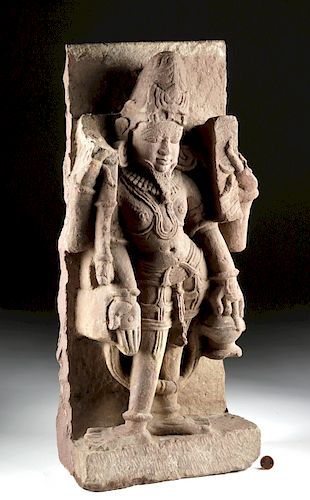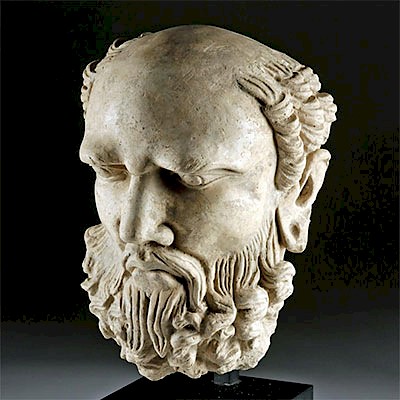4th C. Indian Gupta Sandstone Relief Panel - Vishnu
Lot 164
About Seller
Artemis Fine Arts
686 S Taylor Ave, Ste 106
Louisville, CO 80027
United States
Selling antiquities, ancient and ethnographic art online since 1993, Artemis Gallery specializes in Classical Antiquities (Egyptian, Greek, Roman, Near Eastern), Asian, Pre-Columbian, African / Tribal / Oceanographic art. Our extensive inventory includes pottery, stone, metal, wood, glass and textil...Read more
Categories
Estimate:
$6,500 - $9,750
Absentee vs Live bid
Two ways to bid:
- Leave a max absentee bid and the platform will bid on your behalf up to your maximum bid during the live auction.
- Bid live during the auction and your bids will be submitted real-time to the auctioneer.
Bid Increments
| Price | Bid Increment |
|---|---|
| $0 | $25 |
| $300 | $50 |
| $1,000 | $100 |
| $2,000 | $250 |
| $5,000 | $500 |
| $10,000 | $1,000 |
| $20,000 | $2,500 |
| $50,000 | $5,000 |
| $100,000 | $10,000 |
| $200,000 | $20,000 |
About Auction
By Artemis Fine Arts
Jan 16, 2020
Set Reminder
2020-01-16 10:00:00
2020-01-16 10:00:00
America/New_York
Bidsquare
Bidsquare : Ancient | Asian | Ethnographic
https://www.bidsquare.com/auctions/artemis-gallery/ancient-asian-ethnographic-4799
Featuring classical antiquities, ancient and ethnographic art from cultures encompassing the globe. Artemis Fine Arts info@artemisgallery.com
Featuring classical antiquities, ancient and ethnographic art from cultures encompassing the globe. Artemis Fine Arts info@artemisgallery.com
- Lot Description
Central Asia, India, Gupta Empire Period, ca. late 3rd to late 6th century CE. A lovely devotional panel carved from red sandstone with a high-relief image of the god Vishnu standing atop an integral rectangular platform. He wears his characteristic conical hat incised with curvilinear motifs, a short skirt ringed with a tasseled belt, and intricate necklaces and garland around his upper body. He leans slightly to the right and presents with an extended right leg. Each of his 4 arms are adorned with bracelets and elaborate finery, and the hands hold various attributes associated with his divine status: an offering seed and conch shell in the lower hands, and a mace/club and a discus in the raised hands. Slender ovoid eyes, a tall nose, full lips, large ears with huge earrings, and a tapering beard comprise the stylized serene visage. Size: 9.8" W x 22" H (24.9 cm x 55.9 cm).
Vishnu is a blue-skinned, four-armed deity central to Hinduism: the protector and preserver of the world to Brahma's creator and Shiva's destroyer. Temples in ancient India were built of brick, with carved stone images like this one set into wall niches. The Gupta period is sometimes referred to as India's Golden Age, when imperial patronage allowed the arts to flourish; this period had great influence on subsequent periods, like that of the Pala Empire and Kashmir. Their refined artistic forms are characterized by fluid, almost whimsical carving, with gentle curves and a geometric attention to symmetry and shape. Many of the artists creating sculptures like this came from the monastic complex of Sarnath.
Provenance: private East Coast, USA collection; ex-Virginia & Col. Edward Dellinger collection, New York, USA, acquired in the 1960s
All items legal to buy/sell under U.S. Statute covering cultural patrimony Code 2600, CHAPTER 14, and are guaranteed to be as described or your money back.
A Certificate of Authenticity will accompany all winning bids.
We ship worldwide and handle all shipping in-house for your convenience.
#142449This panel is from a larger sandstone carving. Losses to some attributes, small chips to base, body, and limbs, with softening to some finer details, and light encrustations within recessed areas. Light earthen deposits throughout. Chisel marks on verso from being separated from larger carving.Condition
- Shipping Info
-
All shipping is handled in-house for your convenience. Your invoice from Artemis Gallery will include shipping calculation instructions. If in doubt, please inquire BEFORE bidding for estimated shipping costs for individual items.
-
- Buyer's Premium



 EUR
EUR CAD
CAD AUD
AUD GBP
GBP MXN
MXN HKD
HKD CNY
CNY MYR
MYR SEK
SEK SGD
SGD CHF
CHF THB
THB














